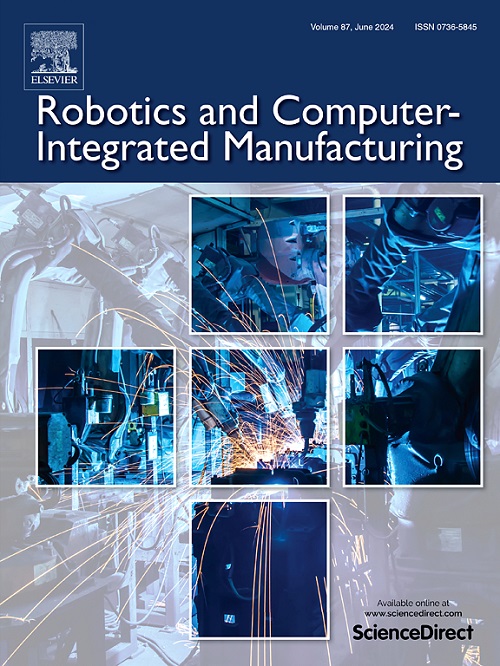基于现场扫描点云的光滑、刚性、灵巧机器人加工路径规划
IF 11.4
1区 计算机科学
Q1 COMPUTER SCIENCE, INTERDISCIPLINARY APPLICATIONS
引用次数: 0
摘要
具有集成传感单元的工业机器人具有并行性、灵活性和智能操作的优点,使其成为大型昂贵机床的经济实惠的替代品,用于加工大型复杂部件,如飞机外壳、船体和风力涡轮机叶片。这些复杂的零件在运输、夹紧和装配过程中容易变形。因此,利用机器人对被夹件进行现场扫描获取点云,并基于这些点云进行自适应加工路径规划是一种可行的方法。提出了一种基于现场扫描点云的光滑、刚性、灵巧机器人加工路径规划方法,该方法适用于半精加工或精加工阶段。首先,提出了一种对偶四元数非均匀有理b样条(NURBS)曲线拟合方法,从点云中生成光滑的刀具路径;然后,针对机器人的功能冗余问题,提出了一种选择所有加工路径点姿态的方法,在关节限制约束下优化机器人关节空间轨迹的平整度、刚度和灵巧度,并避免碰撞。构造了一个以机器人构型为节点的有向图,提出了一种改进的A*算法来寻找有向图中的最短路径。通过仿真和实际机器人切削实验,得到了可执行的机器人加工路径,实现了关节空间轨迹平稳性、刚度和灵巧性的良好平衡。本文章由计算机程序翻译,如有差异,请以英文原文为准。
Smooth, rigid, and dexterous robotic machining path planning based on on-site scanned point clouds
Industrial robots with integrated sensing units possess the advantages of parallelism, dexterity, and intelligent operation, making them a cost-effective alternative to large and expensive machine tools for processing large and complex parts such as aircraft skins, ship hulls, and wind turbine blades. These complex parts are susceptible to deformation during transportation, clamping, and assembly. Therefore, employing robots to perform on-site scanning of clamped parts to acquire point clouds and subsequently conducting adaptive machining path planning based on these point clouds is a viable approach. In this paper, a novel method for planning a smooth, rigid, and dexterous robotic machining path based on on-site scanned point clouds is presented, which is suitable for the semi-finishing or finishing stages. First, a dual quaternion non-uniform rational B-spline (NURBS) curve fitting method is proposed to generate a smooth tool path from the point clouds. Then, to address the functional redundancy of the robot, a method is proposed to select the postures of all machining path points, optimizing the smoothness of the robot's joint space trajectory, rigidity, and dexterity under the constraints of joint limitations and avoiding collisions. A directed graph with robot configurations as its nodes is constructed, and an improved A* algorithm is proposed to find the shortest path in the directed graph. We conducted simulations and actual robotic cutting experiments, which demonstrated that executable robotic machining paths can be obtained, achieving a superior balance of joint space trajectory smoothness, rigidity, and dexterity.
求助全文
通过发布文献求助,成功后即可免费获取论文全文。
去求助
来源期刊
CiteScore
24.10
自引率
13.50%
发文量
160
审稿时长
50 days
期刊介绍:
The journal, Robotics and Computer-Integrated Manufacturing, focuses on sharing research applications that contribute to the development of new or enhanced robotics, manufacturing technologies, and innovative manufacturing strategies that are relevant to industry. Papers that combine theory and experimental validation are preferred, while review papers on current robotics and manufacturing issues are also considered. However, papers on traditional machining processes, modeling and simulation, supply chain management, and resource optimization are generally not within the scope of the journal, as there are more appropriate journals for these topics. Similarly, papers that are overly theoretical or mathematical will be directed to other suitable journals. The journal welcomes original papers in areas such as industrial robotics, human-robot collaboration in manufacturing, cloud-based manufacturing, cyber-physical production systems, big data analytics in manufacturing, smart mechatronics, machine learning, adaptive and sustainable manufacturing, and other fields involving unique manufacturing technologies.

 求助内容:
求助内容: 应助结果提醒方式:
应助结果提醒方式:


